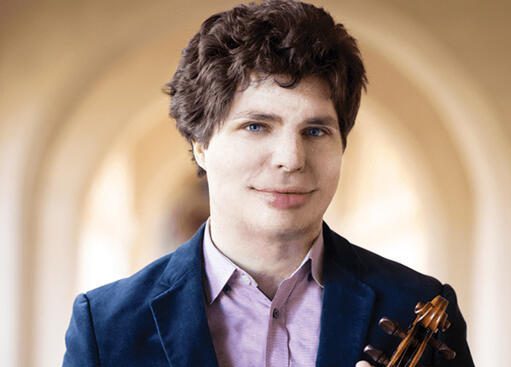Grammy-winning faculty member to perform violin recital
At a Sunday afternoon concert in the Morse Recital Hall, YSM professor Augustin Hadelich plans to perform Bach and the blues.

Courtesy of Suxiao Yang
On Sunday afternoon, Grammy Award-winning violinist and Yale School of Music professor Augustin Hadelich will give his first recital at Yale since joining the faculty in 2021.
The world-renowned violinist teaches an intimate studio of five accomplished musicians in his position at Yale. Known for his technical virtuosity and original interpretations, Hadelich will play a varied and demanding program at his Sunday concert, featuring the music of J.S. Bach, Eugène Ysaÿe and Coleridge-Taylor Perkinson. Presented as part of the YSM’s Faculty Artist Series, the performance will begin at 3 p.m. in the Morse Recital Hall.
“I like programming music that looks weird together on paper, but that works nicely together in practice,” Hadelich noted.
His violin program for Sunday spans over 250 years, expressing a wide range of emotions and incorporating stylistic elements from the blues.
The recital will open with Bach’s Violin Partita No. 3 in E Major. The rapid string crossings of its exuberant “Preludio” will be a chance for Hadelich to showcase his technical execution abilities.
“Blue/s Forms,” a piece by pioneering Black composer Coleridge-Taylor Perkinson, will follow.
“[Perkinson’s] pieces are pretty difficult, and that presents an obstacle,” Hadelich said. “You need to know that the piece is good before learning it, but you can’t know if it’s good before someone learns it. So that is a bit of a hurdle that new pieces have to overcome.”
As a result of Hadelich recording Blue/s Forms during the COVID-19 pandemic and posting it on his YouTube channel, he said that more musicians have started to play the work, including students at YSM.
Hadelich hopes that recital attendees will be surprised to hear a blues piece follow standard classical repertoire, but he doesn’t believe that they will find the transition too shocking. Bach and Perkinson both incorporated stylistic elements from their time: dance forms for Bach, and the blues for Perkinson.
The next piece, Ysaÿe’s Sonata No. 2, recalls Bach’s “Preludio” in direct quotation. But the aptly named “Obsession” sonata places Bach in contrast with its explorations of obsession, melancholy and fury. The sonata, dedicated to the early twentieth century violinist Jacques Thibaud, is also known for its technical difficulty.
“I don’t know what Ysaÿe was trying to tell Thibaud with the dedication,” Hadelich joked.
Hadelich will conclude the program with the chaconne from Bach’s tragic D Minor Partita, which Hadelich describes as “a monumental mountain to climb.” Hadelich described the piece as “the greatest tragic music” and, contrary to what you may expect, believes it will “leave you uplifted.”
Professor Hadelich finds time to teach his five students at the YSM even while maintaining a dizzying schedule of performances and global tours. The teaching process helps him “to crystalize all [his] thoughts about a piece” which he finds helpful to his own playing. He adds that his students motivate him.
“My students are great,” Hadelich said. “When they’re playing really well, they make me want to play the violin.”
Ani Kavafian, professor of violin and coordinator of string studies at the YSM, regards Augustin Hadelich as “an elegant, exciting, beautiful player.”
Kavafian said “it was euphoria” when Hadelich joined the faculty in 2021, recalling a past conversation with YSM dean Robert Blocker in which she told him that he would “be the greatest dean in the whole world” if he could bring Hadelich on board.
Furthermore, Kavafian shared that she was “thrilled” that Hadelich was interested in teaching given his career as a soloist with “tremendous amounts of concerts.” Kavafian herself has played with leading orchestras across the world, and understands the challenges of balancing a career as both a teacher and performer. She notes that “wherever he is, he makes himself available.”
“He’s a player that thinks about what he is doing, and so he can teach…the way he relates to his students is just really special,” Kavafian said.
According to students, Hadelich’s teaching style is unconventional. His approach is to encourage the development of students’ artistic potential without ever being prescriptive.
“There is no sense of restriction in his teaching,” said Charlie Lovell-Jones MUS ’24. “If he’s convinced by what you’re doing, he’ll let you do it.”
Emma Meinrenken MUS ’24 added that Hadelich’s style was “open and creative in nature,” focusing on “exploring what is possible [musically] rather than exploring what is necessarily right.”
Hadelich’s experiences as a touring musician have given him important insights into the practical aspects of performing a wide variety of violin repertory, his students said. Herdís Guðmundsdóttir MUS ’23 said that Hadelich could tell them “exactly where the orchestra will be late on their entrances.”
Hadelich’s concert this Sunday is composed entirely of unaccompanied violin music, a program that Professor Kavafian finds “really makes people familiar with somebody’s playing.” She believes one thing is certain: “everybody’s going to love it and want more.”
Hadelich performs on the 1744 “ex-Leduc, Szeryng” Guarneri ‘del Gesu’ violin.







